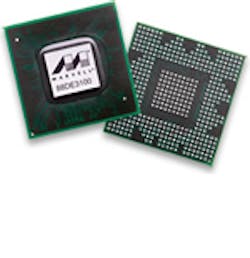Marvell has a full architecture license from ARM versus the hoard of ARM licensees that license individual architectures like the Cortex-M3 or Cortex-A9. Marvell also has substantial technology when it comes to other SoC (system-on-chip) peripherals including graphics and streaming multimedia. It is using this expertise with its new Armada 1500 Foresight Platform that is hosting Google TV along with other multimedia platforms.
The Armada 1500 HD Media System-on-a-Chip is based around dual 1.2 GHz ARM v6/7-compatible PJ4B SMP super-scalar cores. These cores share a 512 byte L2 cache and churn out more than 6000 Dhrystone MIPS. They implement the instruction set includes WMMX2 SIMD instruction support. The floating point unit supports Arm's FPU v3.0 architecture.
The chip has the usual connectivity peripheral set. This includes 6 Gbit/s SATA 3.0 for storage. Connectivity includes USB 2.0, 1 Gigabit Ethernet, SPI, and I2C.
What makes this family of chips stand out is its multimedia support especially on the video side. Not surprising since the Foresight Platform target applications such as smart HDTVs, Blu-ray players, and advanced set top boxes. It handles HDMI, VGA, and composite video outputs and Marvell is working on versions with satellite and cable delivery mechanisms built in. The VMeta multi-format video decoder/encoder/transcoder can deliver to two 1080p streams. The Qdeo video processing system provides state-of-the-art HD including support for scaling, noise reduction, de-interlacing, low bit-rate internet video enhancement and FRC and color/contrast enhancement. The Vivante GC1000 GPU processing element handles 2D and 3D graphics.
The chips also target protected, DRM (digital rights management) content. This includes a content security engine that is required by streaming portal providers. The chip can support applications stored in encrypted DRAM and keys are kept in OTP (one-time programmable) storage.
Low power operation is also part of the design. The Foresight Platform uses advanced cell phone-like power management support.
About the Author
William G. Wong
Senior Content Director - Electronic Design and Microwaves & RF
I am Editor of Electronic Design focusing on embedded, software, and systems. As Senior Content Director, I also manage Microwaves & RF and I work with a great team of editors to provide engineers, programmers, developers and technical managers with interesting and useful articles and videos on a regular basis. Check out our free newsletters to see the latest content.
You can send press releases for new products for possible coverage on the website. I am also interested in receiving contributed articles for publishing on our website. Use our template and send to me along with a signed release form.
Check out my blog, AltEmbedded on Electronic Design, as well as his latest articles on this site that are listed below.
You can visit my social media via these links:
- AltEmbedded on Electronic Design
- Bill Wong on Facebook
- @AltEmbedded on Twitter
- Bill Wong on LinkedIn
I earned a Bachelor of Electrical Engineering at the Georgia Institute of Technology and a Masters in Computer Science from Rutgers University. I still do a bit of programming using everything from C and C++ to Rust and Ada/SPARK. I do a bit of PHP programming for Drupal websites. I have posted a few Drupal modules.
I still get a hand on software and electronic hardware. Some of this can be found on our Kit Close-Up video series. You can also see me on many of our TechXchange Talk videos. I am interested in a range of projects from robotics to artificial intelligence.

